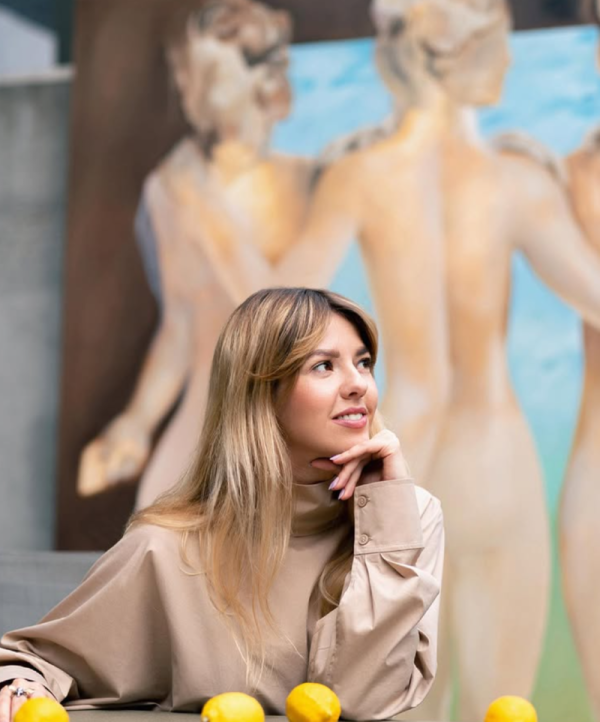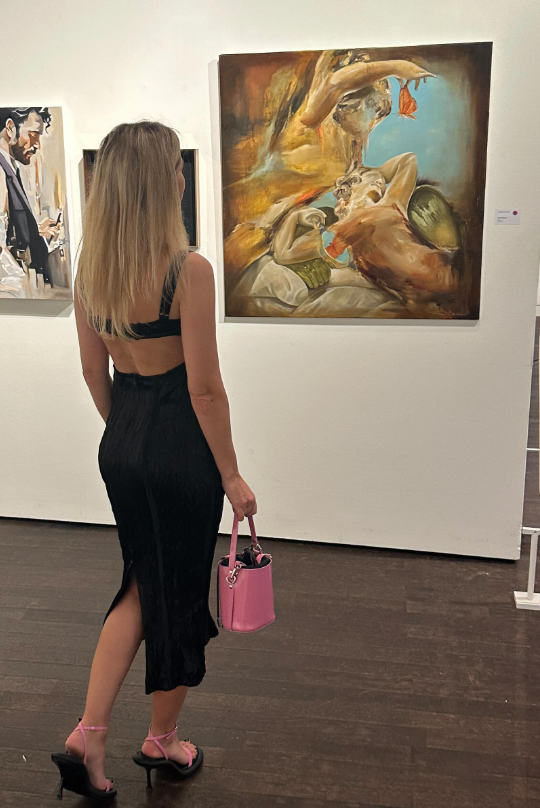
The practice of the emerging Ukrainian painter mariia Hoshovska engages with the dialectic between memory and erasure, presence and absence, resilience and fragility.
Her recent works foreground blurred human figures and fragmented gestures, which, rather than asserting representational clarity, articulate a phenomenology of incompleteness.
In doing so, they open interpretive space for the viewer, situating the act of looking as an extension of affective participation.
This strategy reflects a broader post-Soviet artistic discourse, in which artists frequently negotiate the legacy of cultural tradition alongside contemporary conditions of crisis.
By destabilizing form through blurring and partial erasure, the artist resists fixed signification and privileges ambiguity as both aesthetic and political stance.

Her formal training in the restoration of stone sculpture in Lviv provides an important point of departure for her current practice. Restoration demands patience, material sensitivity, and respect for historical continuity — qualities that have translated into her painterly process.
The layering of pigment in her canvases functions analogously to the stratification of stone, embedding notions of temporality, erosion, and endurance within the visual field.
At the same time, the artist consciously negotiates the commercial dimension of contemporary art. Participation in gallery collaborations and international art fairs, alongside digital dissemination, reveals an awareness of the structures through which artistic visibility is sustained.

This negotiation reflects the dual imperative faced by many emerging artists: maintaining aesthetic integrity while securing institutional presence.
The geopolitical conditions of Ukraine profoundly inform her artistic vocabulary.
The ongoing war has intensified the urgency of her work, rendering its surfaces increasingly fragile and its figures more spectral. Faces and bodies dissolve into indistinct gestures, embodying the disruption of lives and memories under conditions of violence and displacement.
Her painting Unspoken may be read as paradigmatic of this tendency.

The work foregrounds silent gestures of solidarity, suggesting that affective bonds can persist in the absence of physical proximity. Such visual strategies not only respond to the current conflict but also inscribe resilience into the pictorial field, thereby positioning art as a mode of resistance and cultural continuity.
Intercultural Dialogues
The artist situates her practice within a transnational framework, drawing inspiration from diverse contexts.
She identifies affinities with Korean contemporary art, particularly its negotiation of tradition and innovation, as well as with Italian practices that balance classical heritage with modern experimentation.
These references indicate her positioning within a broader global discourse in which national identity intersects with shared concerns of memory, trauma, and representation. Her articulation of being “in between” — between past and present, tradition and abstraction, tenderness and strength — encapsulates the liminal space her work occupies.
It is precisely in this space of in-betweenness that her contribution to contemporary Ukrainian art can be located: as both an extension of cultural memory and a reconfiguration of form under conditions of rupture.

Mariia Hoshovska exemplifies the ways in which contemporary Ukrainian artists mediate between cultural tradition and the exigencies of the present. Her use of ambiguity, fragmentation, and incompleteness serves not only as an aesthetic device but also as a critical framework through which resilience and identity are articulated in times of crisis.
In positioning her practice within both local and global dialogues, the artist demonstrates how painting can operate as a site of cultural memory, political resistance, and affective transmission.
Her work, therefore, contributes meaningfully to ongoing scholarly conversations regarding the role of art in contexts of trauma, displacement, and transnational exchange.

Emerging but already resonant, mariia hoshovska paints at the threshold of memory and erasure, presence and absence. Her works are not only documents of a personal journey but also symbols of a nation’s resilience. As she brings her art to Korea, she expands the conversation beyond borders, offering images that, though blurred, speak with undeniable clarity about what it means to survive, to remember, and to love.
biguity, fragmentation, and incompleteness serves not only as an aesthetic device but also as a critical framework through which resilience and identity are articulated in times of crisis. In positioning her practice within both local and global dialogues, the artist demonstrates how painting can operate as a site of cultural memory, political resistance, and affective transmission. Her work, therefore, contributes meaningfully to ongoing scholarly conversations regarding the role of art in contexts of trauma, displacement, and transnational exchange